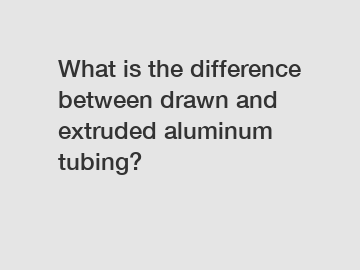What is the difference between drawn and extruded aluminum tubing?
Mar. 19, 2024
Aluminum tubing is a popular choice for various industrial applications due to its lightweight, durability, and corrosion resistance. When it comes to aluminum tubing, there are two commonly used methods for its production: drawn and extruded. While both processes result in high-quality tubing, there are some key differences between them that are worth noting.
**Drawn Aluminum Tubing**.
Drawn aluminum tubing is created by pulling a solid aluminum billet through a die to reduce its diameter and wall thickness. This process is known for producing tubing with precise dimensions and a smooth, uniform finish. Drawn tubing is often used in applications that require tight tolerances and a high-quality surface finish.

One of the main advantages of drawn aluminum tubing is its consistency in wall thickness. Because the tubing is pulled through a die, the wall thickness remains uniform throughout the length of the tube. This makes drawn tubing ideal for applications where dimensional accuracy is critical.
Drawn aluminum tubing also tends to have a higher tensile strength compared to extruded tubing. This makes it a preferred choice for applications that require high strength and durability, such as aerospace components or structural applications.
**Extruded Aluminum Tubing**.
Extruded aluminum tubing is created by pushing a heated aluminum billet through a die to create the desired shape and size. This process results in tubing with a consistent cross-section and good surface finish. Extruded tubing is commonly used in applications where complex shapes or large quantities of tubing are required.
One of the main advantages of extruded aluminum tubing is its ability to create complex shapes with varying wall thicknesses. The extrusion process allows for greater design flexibility, making it suitable for a wide range of applications.
Extruded aluminum tubing is also known for its cost-effectiveness, as the extrusion process allows for high-volume production at a relatively low cost. This makes it a preferred choice for applications that require large quantities of tubing, such as automotive or HVAC systems.
**Key Differences**.
One key difference between drawn and extruded aluminum tubing is the production process itself. Drawn tubing is created by pulling a solid aluminum billet through a die, while extruded tubing is created by pushing a heated aluminum billet through a die. This results in drawn tubing having a higher tensile strength and better dimensional accuracy, while extruded tubing offers greater design flexibility and cost-effectiveness.
Another difference is in the surface finish of the tubing. Drawn tubing tends to have a smoother, more uniform finish compared to extruded tubing, making it ideal for applications where appearance is important. Extruded tubing may have a slight texture due to the extrusion process, but this can be minimized through additional finishing processes if required.
In conclusion, both drawn and extruded aluminum tubing have their own unique characteristics and advantages. The choice between the two will depend on the specific requirements of the application. Drawn tubing is best suited for applications that require tight tolerances and high strength, while extruded tubing is ideal for applications that require complex shapes and cost-effectiveness.
If you have any questions about drawn or extruded aluminum tubing, feel free to contact us for more information. Our team of experts can help you choose the right type of tubing for your specific needs.
Are you interested in learning more about aluminum heat sink extrusion profiles, T Slot Aluminium Profile Manufacturer, Aluminium Profiles for Solar Panel? Contact us today to secure an expert consultation!
308
0
0
Next: None


Comments
All Comments (0)